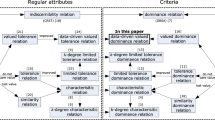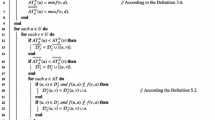Abstract
In this paper, as a naturally generalization of classical information systems, lattice-valued information systems based on dominance relation is proposed. An approach for ranking all objects in this system is constructed consequently, and decision makers can find objects with better property to make an useful and effective decision. In addition, the rough set approach to lattice-valued information systems based on dominance relation is established. And evidence theories in this system are formulated for the analysis of lattice-valued information systems based on dominance relation. What is more, in order to acquire concise knowledge representation and extract much simpler decision rules, the methods of attribute reductions based on discernibility matrix and evidence theory are investigated carefully. These results will be helpful for decision-making analysis in lattice-valued information systems based on dominance relation.
Similar content being viewed by others
References
Ananthanarayana VC, Narasimha MM, Subramanian DK (2003) Tree structure for efficient data mining using rough sets. Patt Recogn Lett 24:851–862
Banerjee M, Pal SK (1996) Roughness of a fuzzy set. Inform Sci 93:235–246
Biswas R (1992) On rough sets and fuzzy rough sets. Bull Pol Acad Sci Math 42:345–349
Biswas R (1994) On rough fuzzy sets. Bull Pil Acad Sci Math 42:352–355
Chan CC (1998) A rough set approach to attribute generalization in data mining. Inform Sci 107:169–176
Cheng W, Mo ZW, Wang J (2007) Notes on “the lower and upper approximations in a fuzzy group” and “rough ideals in semigroups”. Inform Sci 177:5134–5140
Davvaz B, Mahdavipour M (2006) Roughness in modules. Inform Sci 176:3658–3674
Dempster AP (1967) Upper and lower probabilities induced by a multi-valued mapping. Ann Math Stat 38:325–339
Dubois D, Prade H (1990) Rough fuzzy sets and fuzzy rough sets. Int J Gen Syst 17:191–209
Dubois D, Prade H (1992) Putting fuzzy sets and rough sets together. In: Slowinski R (ed) Intelligent decision support. Kluwer Academic, Dordrecht, pp 203–232
Gong ZT, Sun BZ, Chen DG (2008) Rough set theory for the interval-valued fuzzy information systems. Inform Sci 178:1968–1985
Greco S, Matarazzo B, Slowinski R (1999) Rough approximation of a preference relatioin by dominance relatioin. Eur J Oper Res 117:63–83
Greco S, Matarazzo B, Slowinski R (1998) A new rough set approach to multicriteria and multiattribute classificatioin. In: Polkowsik L, Skowron A (eds) Rough sets and current trends in computing (RSCTC’98), Lecture Notes in Artificial Intelligence, vol 1424. Springer, Berlin, pp 60–67
Greco S, Matarazzo B, Slowinski R (1999) A new rough sets approach to evaluation of bankruptcy risk. In: Zopounidis X (ed) Operational tools in the management of financial risks. Kluwer, Dordrecht, pp 121–136
Greco S, Matarazzo B, Slowinski R (2001) Rough set theory for multicriteria decision analysis. Eur J Oper Res 129:11–47
Greco S, Matarazzo B, Slowinski R (2002) Rough sets methodology for sorting problems in presence of multiple attributes and criteria. Eur J Oper Res 138:247–259
Greco S, Matarazzo B, Slowinski R (2007) Dominance-based rough set approach as a proper way of handling graduality in rough set theory. In: Transaction on rough sets VII, lecture notes in computer science, vol 4400, pp 36–52
Guan YY, Wang HK (2006) Set-valued information systems. Inform Sci 176:2507–2525
Hu QH, Pan W, An S, Ma PJ, Wei JM (2010) A efficient gene selection technique for cancer recognition based on neighborhood mutual information. Int J Mach Learn Cybern 1(1–4):63–74
Kryszkiewicz M (1998) Rough set approach to incomplete information systems. Inform Sci 112:39–49
Kryszkiewicz M (1999) Rules in incomplete information systems. Inform Sci 113:271–292
Leung Y, Fischer MM, Wu WZ, Mi JS (2008) A rough set approach for the discovery of classification rules in interval-valued information systems. Int J Approx Reason 47:233–246
Leuang Y, Wu WZ, Zhang WX (2006) Knowledge acquisition in incomplete information systems: a rough set approach. Eur J Oper Res 168:164–180
Nakamura A (1998) Fuzzy rough sets. Note Multiple Valued Logic Jpn 9:1–8
Nanda S (1992) Fuzzy rough sets. Fuzzy Sets Syst 45:157–160
Pawlak Z (1982) Rough sets. Int J Comput Inform Sci 11:341–356
Pawlak Z (1991) Rough set: theoretical aspects of reasoning about data. Kluwer Academic Publishers, Dordrecht
Pawlak Z (2005) Some remarks on conflict analysis. Eur J Oper Res 166:649–654
Pawlak Z, Skowron A (2007) Rudiments of rough sets. Inform Sci 177:3–27
Pawlak Z, Skowron A (2007) Rough sets and Boolean reasoning. Inform Sci 177:41–73
Qian YH, Dang CY, Liang JY, Tang DW (2009) Set-valued ordered information systems. Inform Sci 179:2809–2832
Qian YH, Liang JY, Dang CY (2008) Interval ordered information systems. Comput Math Appl 56:1994–2009
Shafer G (1976) A mathematical theory of evidence. Princeton University Press, Princeton
Shao M.W, Zhang W.X (2005) Dominance relation and relus in an incomplete ordered information system. Intern J Intell Syst 20:13–27
Skowron A, Stepaniuk J (1996) Tolerance approximation spaces. Fundam Inform 27:245–253
Skowron A, Graymala-Busse J (1994) From rough set theory to evidence theory. In: Yager RR, Fedrizzi M, Kacprzyk J (eds) Advance in the Dempster–Shafer theory of evidence. Wiley, New York
Slowinski R, Vanderpooten D (2000) A generalized definition of rough approximations based on similarity. IEEE Trans Knowl Data Eng 12:331–336
Sun BZ, Gong ZT, Chen DG (2008) Fuzzy rough set theory for the interval-valued fuzzy information systems. Inform Sci 178:2794–2815
Swiniarski RW, Skowron A (2003) Rough set method in feature selection and recognition. Patt Recogn Lett 24:833–849
Tsumoto S (1998) Automated extraction of medical expert system rules from clinical databases based on rough set theory. Inform Sci 112:67–84
Vagin V, Fomina M (2011) Problem of knowledge discovery in noisy databases. Int J Mach Learn Cybern 2:135–145
Wang XZ, Tsang E, Zhao SY, Chen DG, Yeung D (2007) Learning fuzzy rules from fuzzy examples based on rough set techniques. Inform Sci 117(20):4493–4514
Wang XZ, Zhai JH, Lu SX (2008) Induction of multiple fuzzy decision trees based on rough set technique. Inform Sci 178(16):3188–3202
Wu WZ, Leung Y, Zhang WX (2002) Connections between rough set theory and Dempster–Shafer theory of evidence. Intern J Gen Syst 31:405–430
Wu WZ, Zhang M, Li HZ, Mi JS (2005) Knowledge reduction in random information systems via Dempster–Shafer theory of evidence. Inform Sci 174:143–164
Xiao QM, Zhang ZL (2006) Rough prime ideals and rough fuzzy prime ideals in semigroups. Inform Sci 176:725–733
Xu WH, Zhang WX (2007) Measuring roughness of generalized rough sets induced by a covering. Fuzzy Sets Syst 158:2443–2455
Xu WH, Zhang XY, Zhong JM, Zhang WX (2010) Attribute reduction in ordered information systems based on evidence theory. Knowl Inform Syst 25:169–184
Yang XB, Song XN, Chen ZH, Yang JY (2011) On multigranulation rough sets on incomplete information system. Int J Mach Learn Cybern. doi:10.1007/s13042-011-0054-8
Yao YY (1998) Relational interpretations of neighborhood operators and rough set approximation operators. Inform Sci 101:239–259
Yao YY, Lingras P (1998) Interpretations of belief functions in the theory of rough sets. Inform Sci 104:81–106
Zhang WX, Leung Y, Wu WZ (2003) Information system and knowledge discovery. Science Press, Beijing
Zhang WX, Qiu GF (2005) Uncertain decision making based on rough sets. Science Press, Beijing
Zhu W, Wang SP (2011) Matroidal approaches to generalized rough sets based on relations. Int J Mach Learn Cybern 2(4):273–279
Acknowledgments
The authors would like to thank the anonymous referees for their valuable comments and suggestions. This work is supported by National Natural Science Foundation of China (No. 61105041, 71071124 and 11001227), Postdoctoral Science Foundation of China (No. 20100481331) and Natural Science Foundation Project of CQ CSTC (No. cstc2011jjA40037).
Author information
Authors and Affiliations
Corresponding author
Rights and permissions
About this article
Cite this article
Xu, W., Liu, S. & Zhang, W. Lattice-valued information systems based on dominance relation. Int. J. Mach. Learn. & Cyber. 4, 245–257 (2013). https://doi.org/10.1007/s13042-012-0088-6
Received:
Accepted:
Published:
Issue Date:
DOI: https://doi.org/10.1007/s13042-012-0088-6




